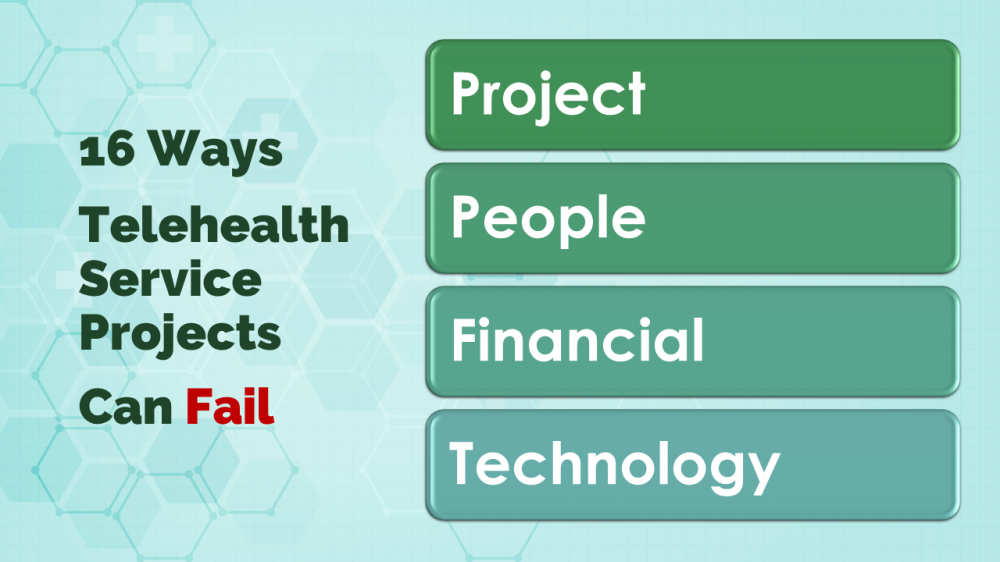The first association most people make with Telehealth is technology. The word tele (as in telescope, telegraph, and telephone) implies that you need technology to make telehealth work. Which is true, but, as it turns out, only a small part of the equation. In the first two parts of this series I implicitly highlighted that fails at the project level, as well as people-related and finance-related fails are what is causing telehealth services not to deliver what was expected or, worse, promised.
To recap, here are the four categories of fails:
I. Project-level fails, that are best remedied through proper project management.
II. People-related fails, that are most easily avoided through proper organizational change management.
III. Financially-related fails, caused by decisions rooted in the lack of experience of telehealth financials.
IV. Technology-related fails, that ironically are often caused by focusing too much on the technology and not enough on the people and processes.



In Part 1 and Part 2 we covered the first 12 fails:
I. Project-level Fails
1) Time Fail
2) Budget Fail
3) Scope Fail
4) Quality Fail
II. People-related Fails
5) Confusion Fails
6) Hesitancy Fails
7) Frustration Fails
8) Resistance Fails
III. Finance-related fails
9) Lack of Reimbursement
10) Unfulfilled Savings
11) Fixed Cost too High
12) Unsustainable
Here are the remaining four fails that are related to technology:
13) One Size Fits All. When the decision on telehealth technology and telehealth vendors is put in the hands of the healthcare organization’s CIO and CTO, their desire — given their experience with Health IT — is to find a single solution (or at least a single vendor) for all things telehealth. Too painful are the headaches of supporting multiple EMRs, multiple CRMs, multiple BI tools and, having learned the lessons from the past, the desire is to just settle on a single technology.
As readers of this newsletter and my articles surely appreciate, telehealth has hundreds of applications across dozens of specialties, occuring in a dozen different types of locations and most use cases require a technology that is optimized to the service. A One-Size-Fits-All strategy simply does not work for telehealth. A direct-to-consumer solution requires a different technology than TeleStroke or a visit-only tele-specialty service for patients presenting in a rural clinic.
That does not mean that 50 different telehealth use cases should be implemented using 50 different technologies. But fitting a square peg into a round hole is not going to help physicians and patients achieve a great experience.
14) User-Unfriendly.
Of course nobody would purposefully select the less user friendly solution, but often other dynamics are in play that lead to the selection of a solution that may not be the most optimal. Many elegant solutions exist in the telehealth world, but most of the slick solutions are offered by unknown, young, venture-capital funded companies that established healthcare organizations typically (and oftentimes rightfully) are hesitant to invest in (since these startups may not be around a few years from now). However, that does not mean that one should go with the titans (and dinosaurs) of the industry, that are also offering telehealth solutions, as that thinking may backfire when the solution is, as unfortunately is quite often the case, cumbersome to use, designed based on decades-old standards.
As an example, one of my clients’ IT department insisted on using their legacy vendors’ video conferencing solution which delayed the use by 3 months since the technology would not work outside the firewall and the user interface is cluttered and clunky and the patient-facing side didn’t look as clean and professional as it should — simply because it was never designed to be used for telemedicine. Of course the telemedicine physicians were not consulted in that decision and it was purely based on relatively minimal savings of a few thousand dollars.
The obvious remedy for this fail is to engage the telemedicine practitioners in the decision making process and to also rely on the expertise of experienced telehealth service designers, not IT managers.
15) Inadequate Access.
When I refer to “technology”, I am not just referring to the hardware and software in the hands of the physicians and patients, but also about the technology that connects the two and is often taken for granted: the network.
When you work and live in an urban or suburban environment, it is easy to forget that the vast area of the US is not enjoying 100 Mbps connections to the internet and often can consider themselves lucky if they can get 2 bars on a 3G connection before their smartphone drops back to the painfully-slow EDGE.
In rural clinics, the network connectivity is the wireless infrastructure and the capabilities of the local internet provider. In home-based use cases such as remote patient monitoring, home-based telecare or direct-to-consumer telemedicine, this means the patient’s local internet connectivity which often just may be the cellular network.
The remedy here is to be clear about the patient population you’ll be serving and to verify the connectivity before jumping in with both feet to the launch of a telehealth service that in the end the people,, that the service was intended for,, cannot access.
16) Over-reliance on Vendors.
The last technology-related fail was a close call between this one and being infatuated with the technology (such as a remote-controlled robot haunting the hospital halls). The over-reliance on vendors mostly shows up in two different ways: in having to adapt your processes to the built-in idiosyncrasies of the solution and in the vendor’s lack of experience integrating the technology into your workflows.
Many technology solutions, especially those with a software component to it, have an implicit workflow paradigm embedded in their design. If that paradigm does not align with your workflows or with the mindset of the people that will be using the solution, your telehealth service will fail due to the confusion and frustration (at best) or outright resistance (at worst) to use the technology.
Secondly, most vendors have very little experience (or even financial incentive, after they’ve made the sale) to help you with the integration of their solution into your workflows. At best they will provide deployment and configuration guides and guidance on how to integrate the solution into the technical infrastructure. But since the care delivery workflows at every healthcare organization (and even across different telehealth services within an organization) are often unique (after all, in most cases you are tele-enabling an existing service), vendors cannot and will not think beyond their “reference implementation” they had in mind when they designed their solution.
For both ways, the remedy is to first design your telehealth service workflows before selecting a solution, so you can evaluate the solution based on your workflow and process needs. If you select a solution that does not quite match but that you like nonetheless, you can then at least make a conscious choice to change your workflows to match the solution. In addition, I recommend the use of an experienced clinical workflow specialist to aid in the design and rollout of the solution from a process integration perspective.
16 Ways to Succeed in Telehealth
This wraps up my series on the 16 ways in which telehealth services can fail and it is my sincere hope that these insights can help you to find 16 ways to increase the likelihood of success in designing and rolling out your telehealth services.
For advice or guidance on how to design and rollout telehealth services in your clinic, hospital, or health system, you can reach me through the various means listed below.
Send me your responses by replying to this email or comment on this article on LinkedIn.








To receive articles like these in your Inbox every week, you can subscribe to Christian’s Telehealth Tuesday Newsletter.
Christian Milaster and his team optimize Telehealth Services for health systems and physician practices. Christian is the Founder and President of Ingenium Digital Health Advisors where he and his expert consortium partner with healthcare leaders to enable the delivery of extraordinary care.
Contact Christian by phone or text at 657-464-3648, via email, or video chat.







Leave A Comment